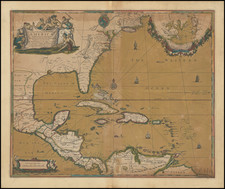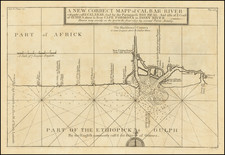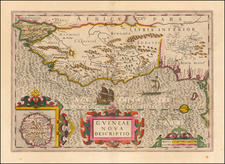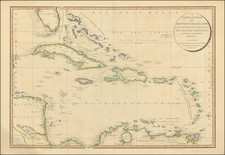Decorative map centered on the Atlantic and showing the route of Jan Stadens between Europe, Africa and South America.
The map illustrated an early account of the New World published by Vander Aa, one of the most prolific compilers of information on the early explorations to America, Asia and Africa.
Hans Staden
Hans Staden (1525 – 1576) was a German soldier and explorer who voyaged to South America in the middle of the sixteenth century, where he was captured by the Tupinambá people of Brazil. He managed to survive and return safe to Europe. In his widely read account describing his travel and captivity, he claimed that the native people that held him captive practiced cannibalism.
Staden was born in Homberg in the Landgraviate of Hesse. He first enlisted in 1547 on a ship that was bound for Brazil. He returned from this first trip in October 1548. He next went to Seville and enlisted for a second trip as a volunteer in an expedition for Río de la Plata which sailed in March 1549. On reaching the mouth of the river, two ships sank in a storm. After vainly trying to build a barque, part of the shipwrecked crew set out overland for Asunción. The rest of the crew, including Staden (a knowledgeable gunman), sailed upon the third vessel for the island of São Vicente, but were also wrecked. Staden, with a few survivors, made it back to the continent in 1552, where he was hired by the Portuguese.
A few weeks later, while engaged in a hunting expedition, Staden was captured by a party belonging to the Tupinambá people of Brazil, an enemy group of the Tupinikin people and their Portuguese allies. As Staden was part of a Portuguese crew, he was perceived of as an enemy of the Tupinambá and they carried him to their village (the predecessor of today's Ubatuba) where he claimed he was to be devoured at the next festivity. However, Staden allegedly won the favor of the Tupinambá Chief Cunhambebe by translating between the Tupinambá and European traders as well as predicting a Tupinikin attack on the tribe, thus his life was spared. Furthermore, when Staden later claimed to have cured the tribal king and his household from illness through the power of prayer and Christianity, the Tupinambá embraced him and called him "Scheraeire", meaning "Son, do not let me die." The Portuguese tried several times to negotiate for Staden's ransom, but the Indians declined all overtures. At last he made his escape on a French ship, and in February 1555, arrived at Honfleur, in Normandy, and from there went immediately to his native city.
After his return to Europe, the support of Dr. Johann Dryander in Marburg enabled Staden to publish an account of his captivity, entitled Warhaftige Historia und beschreibung eyner Landtschafft der Wilden Nacketen, Grimmigen Menschfresser-Leuthen in der Newenwelt America gelegen (True Story and Description of a Country of Wild, Naked, Grim, Man-eating People in the New World, America) (1557); the book was printed by Andreas Kolbe.
The Warhaftige Historia provided detailed descriptions of Tupinambá life and customs, illustrated by woodcuts. The book became an international bestseller and was translated into Latin and many other European languages, reaching a total of 76 editions. Theodor de Bry produced illustrative engravings of Staden's story for his book Grand Voyages to America (1593), volume 3.
Pieter van der Aa (1659-1733) was a Dutch mapmaker and publisher who printed pirated editions of foreign bestsellers and illustrated books, but is best known for his voluminous output of maps and atlases. Van der Aa was born to a German stonecutter from Holstein. Interestingly, all three van der Aa sons came to be involved in the printing business. Hildebrand was a copper engraver and Boudewyn was a printer.










![Oceani Occidentalis Seu Terrae Novae Tabula [The Admiral's Map]](https://storage.googleapis.com/raremaps/img/small/102935.jpg)



![[Belgian Congo - Katanga ]](https://storage.googleapis.com/raremaps/img/small/99902.jpg)